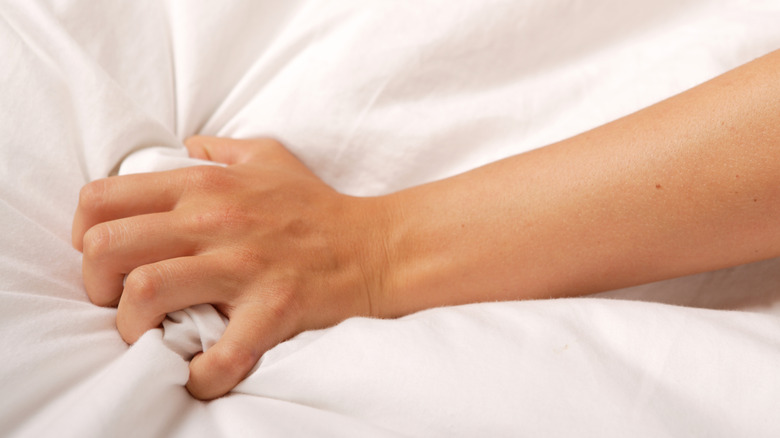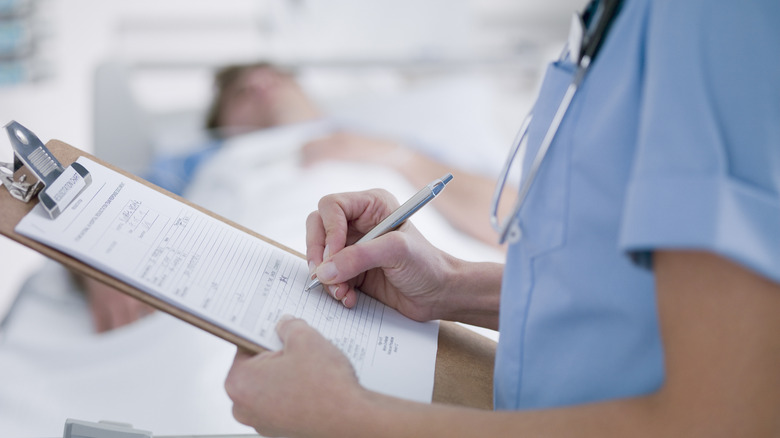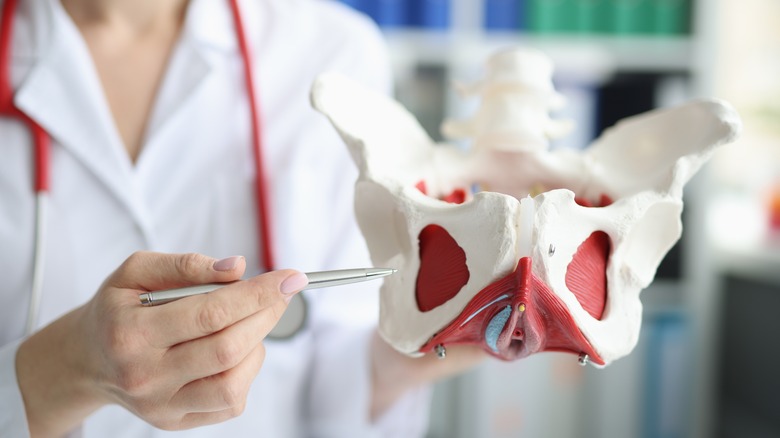The Surprising Condition With The Symptom Of Spontaneous Arousal
According to a study published in the Indian Journal of Psychological Medicine, persistent genital arousal disorder (PGAD) is a very rare sexual health condition where people feel continuous, uncontrollable sexual arousal that doesn't go away even after having an orgasm. Arousal can happen because of things that turn them on or for no apparent reason, causing a lot of stress. According to Healthline, PGAD symptoms can even last for weeks. PGAD was originally referred to as persistent sexual arousal syndrome (PSAS) or restless genital syndrome (ReGS or RGS).
PGAD remains an enigmatic and poorly understood phenomenon. This condition presents significant challenges for both those experiencing it and the healthcare professionals attempting to provide care. Living with PGAD can be immensely demanding, isolating, and profoundly disruptive to daily life, seeing that the lack of awareness and understanding, added to the shame and embarrassment that often accompany the condition, may contribute to a reluctance to seek help. However, since the perpetual state of arousal can interfere with work, relationships, and overall well-being, it is imperative for those with PGAD to seek appropriate medical care and support. On the other hand, given that PGAD has only recently been described, the medical community's understanding of this disorder is still evolving. Thus, healthcare providers may not be well-versed in its diagnosis and treatment, further complicating the journey for those affected. This article tells you all you need to know about PGAD, including its causes, symptoms, and multiple treatment options.
What is persistent genital arousal disorder (PGAD)?
Per a 2022 review in Psychiatria Polska, PGAD is a relatively recent addition to sexual disorders marked by unexpected and intrusive genital arousal without corresponding sexual desire. First described in 2001 by S.R. Leiblum and S.G. Nathan, it is characterized by feelings like pulsation, swelling, and tingling in the genital area, even in the absence of sexual desire or fantasies. Notably, considering that PGAD is a relatively new sexual condition, it has not yet found its place in established medical classifications, which means its treatment and root causes remain unclear.
A study in the Indian Journal of Psychological Medicine explains that one distinctive feature of PGAD is that traditional methods like masturbation and orgasms provide little to no relief. It is important not to confuse PGAD with hypersexuality (despite both conditions involving sexual functioning), seeing that they exhibit significant differences. First, PGAD primarily impacts women, whereas hypersexuality is more commonly associated with men. Second, PGAD leads to persistent genital arousal without an underlying desire for sexual activity; conversely, hypersexuality involves a compulsion for sexual activity rather than a constant state of genital arousal, meaning people have powerful and hard-to-control sexual feelings and desires that become the most important thing in their lives (via Medical News Today).
Furthermore, since PGAD in men may lead to prolonged and recurrent erections, even after ejaculation, it can be mistaken for priapism. However, unlike PGAD, priapism often stems from causes like blood issues, prescription drugs, injury, or substance abuse rather than persistent genital arousal (via the Mayo Clinic).
PGAD causes and risk factors
As explained by a 2022 review in Psychiatria Polska, the precise causes of PGAD remain unclear despite ongoing research efforts. Still, several hypotheses have been proposed to explain its origin, including changes within the blood vessels, nerve damage, medications that may disrupt the normal sexual response, dietary factors, hormonal imbalances, disruptions in the way nerves communicate with one another, mechanical pressure on genital structures, or a combination of the above.
Moreover, Medical News Today adds additional elements to the list. PGAD can be triggered by sexual stimulation, masturbation, anxiety, and stress (which leads to speculation that psychological factors may play a role in its development). Interestingly, some individuals experience intense arousal even during routine activities like going to the toilet, leading to discomfort and pain. Additionally, Tarlov cysts, which are sacs filled with spinal fluid, have also been associated with PGAD because the cysts can affect the nerves responsible for transmitting signals from the brain to the bladder, colon, and genitals, potentially contributing to PGAD symptoms. Lastly, PGAD has been identified as a secondary symptom in people with conditions such as Tourette's syndrome, epilepsy, and post-surgical effects following interventions in the lower back. These conditions may indirectly lead to PGAD by affecting the nervous system or blood flow in the pelvic region.
Regarding an increased risk of developing PGAD, the review says that this condition has predominantly been observed in women, though some cases among men have also emerged in recent years.
Signs and symptoms of PGAD
PGAD is characterized by a cluster of signs and symptoms that can significantly impact your quality of life. First and foremost, central to PGAD is the experience of intense genital arousal, which may last for days and has been linked to increased blood flow to areas like the clitoris, labia, perineum (the space between the genitals and the anus), and the anus itself (via the Cleveland Clinic). When it happens, people with PGAD may experience genital pain or discomfort, tingling sensations in the clitoris, involuntary vaginal contractions and lubrication, and orgasms that seem to come out of nowhere. Moreover, feelings of pressure, pulsating, throbbing, burning, and itching are also described.
Furthermore, according to Healthline, PGAD in women may also affect other body parts, such as the nipples. In contrast, PGAD in men may manifest as general pain in the penis or hours-lasting erections. Additionally, PGAD may lead to facial and neck redness, high blood pressure and heart rate, superficial breathing, muscle cramps, and blurred vision. Lastly, the Cleveland Clinic notes that the sensations related to PGAD differ significantly from the pleasurable feelings of typical sexual arousal and that the condition can profoundly alter your relationship with sexual pleasure, as orgasms become linked with momentary relief from the discomfort caused by the disorder.
PGAD diagnosis
The diagnosis of PGAD relies on specific criteria that help healthcare professionals confirm the condition, per a study in the Indian Journal of Psychological Medicine. First, the patient exhibits bodily responses typically seen during sexual arousal, including heightened sensitivity to the genital area, that should last from hours to days and won't go away on their own. Second, the genital arousal remains even after one or more orgasms. Third, the arousal is involuntary and unwanted. Fourth, it can be set off not just by sexual activity but also by non-sexual triggers, such as vibrations from a car. And fifth, people should feel distressed or bothered due to this ongoing arousal.
Regarding the tests used to confirm a PGDA diagnosis, a study published in the journal Clinical Therapeutics explains that since various factors, such as pelvic injuries or nerve damage, have been associated with PGAD, healthcare providers may need to conduct a thorough assessment involving comprehensive clinical and laboratory investigations, including taking a detailed patient history encompassing sexual and reproductive concerns, as well as a careful review of their medication history to rule out any potential drug-related causes. Plus, clinicians should consider performing an initial laboratory assessment to help rule out any underlying medical conditions, an ultrasound examination of the pelvic organs to check for abnormalities, and magnetic resonance imaging (MRI) scans of the pelvis, brain, spinal cord, and spinal roots to identify any issues of the central nervous system (CNS) that could be contributing to PGAD symptoms. Additionally, an electroencephalogram (EEG) may help evaluate brain activity and rule out any related brain conditions.
Psychological impact of living with PGAD
PGAD can have a profound negative impact on an individual's mental well-being, potentially leading to depression and even suicidal thoughts or attempts. Per a 2022 review in Psychiatria Polska, people with PGAD often experience distress, anxiety, and depression due to the persistent and intrusive nature of their genital arousal, and unsurprisingly, they tend to have fewer sexual thoughts and fantasies compared to those without PGAD symptoms. Moreover, they report feeling distracted, frustrated, and embarrassed, which can significantly affect their daily lives. In fact, a study published in The Journal of Sexual Medicine states that, apart from the emotional impact, PGAD can impair daily functioning by making tasks like working, driving, house chores, and social activities challenging.
Furthermore, research suggests that women with PGAD are more than twice as likely to report experiencing thoughts of suicide compared to women who do not have the condition. Lastly, since people with PGAD may also struggle with anxiety, panic attacks, certain obsessive-compulsive symptoms, and other expected consequences. In short, PGAD affects not only a person's physical state but also their mental health and overall quality of life, making it crucial to address the condition's physical and emotional aspects to provide care and support to those who experience it.
If you or someone you know is struggling or in crisis, help is available. Call or text 988 or chat 988lifeline.org
Pharmacological treatment for PGAD
Treating PGAD can be quite complex because there are no officially approved medications specifically designed for it. Instead, a study in The Journal of Sexual Medicine explains that doctors often rely on "off-label" treatment, which is when medications are used to treat conditions that aren't officially what they were approved for.
According to a study in Clinical Therapeutics, different categories of drugs have been tried to help manage PGAD. For instance, some medications aim to calm down the parts of the brain responsible for sexual arousal, including antidepressant drugs like clomipramine, duloxetine, and tramadol. Another approach is to use antipsychotic drugs that counteract the receptors in the body responsible for sexual excitement. Medications like risperidone and paliperidone fall into this group. Moreover, other drugs aim to reduce the activity of nerve cells, including anticonvulsants like carbamazepine, pregabalin, and topiramate. Additionally, some medications reduce activity in parts of the brain responsible for sexual feelings (aka the "sexual brain"), which happens when people take antiandrogen drugs. Lastly, some medications work to change how the body senses and perceives sensations, such as botox injections or painkillers like tramadol or tetrahydrocannabinol (THC).
However, the study warns that finding the proper medication for PGAD can be challenging because some drugs, like antidepressants, anticonvulsants, and antipsychotics, may also cause PGAD or make its symptoms worse. Thus, treating PGAD is a careful process of trial and error to see which medication, if any, can help manage its symptoms while minimizing unwanted side effects.
Psychological treatment for PGAD
According to a 2023 study in Springer Nature, treating PGAD often involves a combination of psychological approaches to help people manage their symptoms and improve their overall well-being. However, these treatments are not about making the physical sensations disappear, but rather helping people cope better. The combined approaches include psychoeducation, cognitive behavioral therapy (CBT), mindfulness-based therapy, dialectical behavior therapy (DBT), and distress tolerance TIPP skills. When it comes to psychoeducation, a strategy called the Fear-Avoidance Model suggests that if people see their symptoms as threatening, it may lead to catastrophizing, avoidance, and hypervigilance. This, in turn, can lead to more anxiety, sadness, and a lower quality of life. The Fear-Avoidance Model tries to reduce the fear and worry about PGAD, making it easier to manage the symptoms and recover. Meanwhile, CBT has been helpful for other sexual problems; it helps people challenge negative beliefs about PGAD and try new ways of thinking.
Regarding mindfulness-based therapy, it is said to be helpful for women with sexual problems, anxiety, and sadness by reducing pain catastrophizing and stress levels. In contrast, DBT is often used for people with intense emotions and difficulties managing distress; it has been shown to help with chronic pain, which is often the case with PGAD. Lastly, distress tolerance TIPP skills help manage extreme arousal, which can be a big challenge with PGAD. TIPP stands for temperature (such as ice baths), intense exercise, paced breathing, and paired muscle relaxation, which can help individuals cool down and relax when feeling overwhelmed by arousal.
Other types of treatment
PGAD is a complex condition, and its treatment can look different for each person because it mainly depends on what's causing the symptoms. Therefore, there isn't a one-size-fits-all therapy. Instead, doctors must carefully determine the cause before choosing the proper treatment. Per a study published in the journal Clinical Therapeutics, one of the non-medication treatments used for PGAD includes making dietary changes (namely following a soy-based diet). At the same time, some people might benefit from physical therapy specifically designed for the muscles in the pelvic area. There are also treatments that focus on the nerves in the body, and some patients find relief through special devices that use electrical stimulation.
Moreover, a study published in The Journal of Sexual Medicine explains that if the issue is related to nerves, doctors might suggest a pudendal nerve block to reduce symptoms like pelvic pain and problems with urination. There are also treatments for blood vessel problems, like blockages or malformations in the pelvic area, and hormonal therapy might be considered if there are hormonal issues. If it looks like skin-related factors are playing a role, ultrapotent corticosteroids might be recommended. And in cases where the nerves are growing too much, surgery might be an option. Lastly, other potential treatments include pelvic massages, biofeedback (a technique that helps you control certain body functions), numbing creams, acupressure (a type of massage), and muscle relaxant medications (per WebMD).









